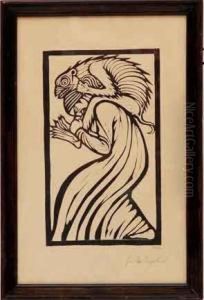Gustav Vigeland Paintings
Gustav Vigeland, born Adolf Gustav Thorsen on April 11, 1869, in Mandal, Norway, is one of the most notable sculptors in Norwegian art history. He is best known for creating the sculpture installations in Frogner Park, Oslo, which is the largest sculpture park in the world by a single artist and is most famous for the Vigeland installation, or Vigeland Sculpture Arrangement.
Vigeland moved to Oslo, then called Kristiania, where he apprenticed under sculptor Brynjulf Bergslien. He later studied with sculptor Auguste Rodin in Paris, which was a significant influence on his later work. Vigeland's style evolved over the years, and he is known for his complex and expressive figures that often depict the human life cycle, from birth to death, in a raw and unembellished manner.
Vigeland's work includes more than 200 sculptures in bronze, granite, and cast iron. He was not only a sculptor but also a designer of the layout and architectural setting of his public works. The Vigeland Park was a result of a unique contract Vigeland made with the city of Oslo: he agreed to donate all his future works to the city in exchange for a studio and living space. Vigeland lived and worked in what is now the Vigeland Museum adjacent to Frogner Park.
Gustav Vigeland died on March 12, 1943, in Oslo. After his death, his studio was turned into the Vigeland Museum, which is dedicated to his life and work. Vigeland’s art is characterized by its universality and its exploration of the human condition, making his sculpture park a popular destination that draws more than one million visitors each year.
